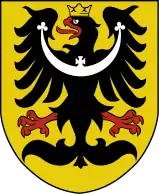Texas Silesian
Texas Silesian (Silesian: Teksasko godka) is a dialect of the Silesian language used by descendants of immigrant Silesians in American settlements from 1852[2] to the present. It is a variant of Silesian derived from the Opole dialect. The dialect evolved after Silesian exile around the village of Panna Maria.[3] It contains a distinctive vocabulary for things which were unknown for Polish Silesians.[4]
| Texas Silesian | |
|---|---|
| Teksasko godka | |
| Native to | United States |
| Region | Panna Maria, Texas |
| Ethnicity | Silesian Americans in Texas |
| Language codes | |
| ISO 639-3 | szl |
| Glottolog | sile1253 |
| Linguasphere | 53-AAA-cck, 53-AAA-dam |

Texas Silesian is less influenced by German because its speakers emigrated before the Kulturkampf, which added many germanisms to the continental Silesian[5] The language is tended by its speakers, but they know it only in the spoken form.[5] Texas Silesian has not been replaced by English because the Silesian community is strongly isolated. Nevertheless, Texas Silesian has adopted some words from English.
One of the characteristic features of Texas Silesian phonetics is called mazuration, in which all cz, sz, ż are pronounced [t͡s, s, z], whereas in the stereotypical Silesian of the Katowice urban area they are pronounced [t͡ʂ, ʂ, ʐ]. Texas Silesian has given the name for Cestohowa village in Texas - the name is derived from Polish Częstochowa, but, due to this phonetic process, cz became c.[4]
Typical words unlike Silesian
| Texas Silesian | Silesian | English |
|---|---|---|
| turbacyjo[4] | ńyprzileżytość | problem |
| zaszanować[4] | zaszporować | to save money |
| kapudrok[4] | zalůńik | frock coat |
| furgocz[5] | fliger | aeroplane |
| szczyrkowa[4] | no native word | rattlesnake |
| po warszawsku[4] | po polsku, po polskimu | in Polish |
| prastarzik[4] | starzik, uopa | great-grandfather |
| ćeżko[4] | fest, fes, fys | very |
| kole tego[6] | uo tym, koly tego | about that |
| pokłoud[5] | gipsdeka | ceiling |
| bejbik[7] | bajtel | baby |
| kara[7] | autok | car |
| wjater[7] | luft | air |
| korn | kukurzica | corn |
| farmjyrz | gospodorz | farmer |
| plumzy, piczesy | fyrcichy | peaches |
| garce | buncloki, garki, gorce | pots |
References
- "Ethnologue report for language code: szl". Ethnologue. Languages of the World.
- http://www.tshaonline.org/handbook/online/articles/hlp04
- "Telewizja TVS". Retrieved 5 March 2015.
- "RADIO COURIER". Archived from the original on 3 November 2007. Retrieved 5 March 2015.
- "Archived copy". Archived from the original on 2009-12-21. Retrieved 2009-01-27.CS1 maint: archived copy as title (link)
- "ŚLŮNSKO EKA - Ze gyšychty našyj godki". Archived from the original on 6 March 2008. Retrieved 5 March 2015.
- "Inne". katowice. Retrieved 5 March 2015.

